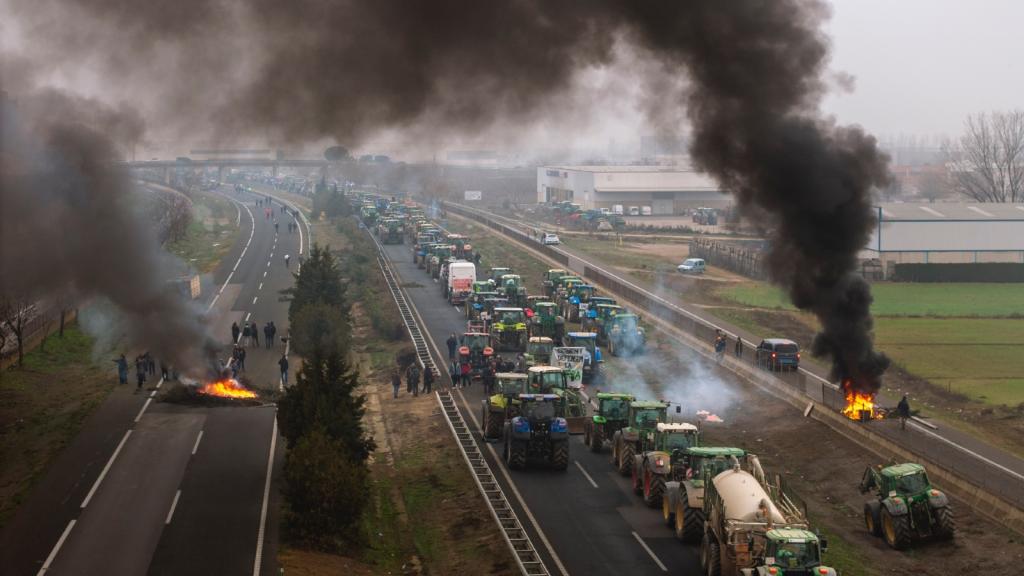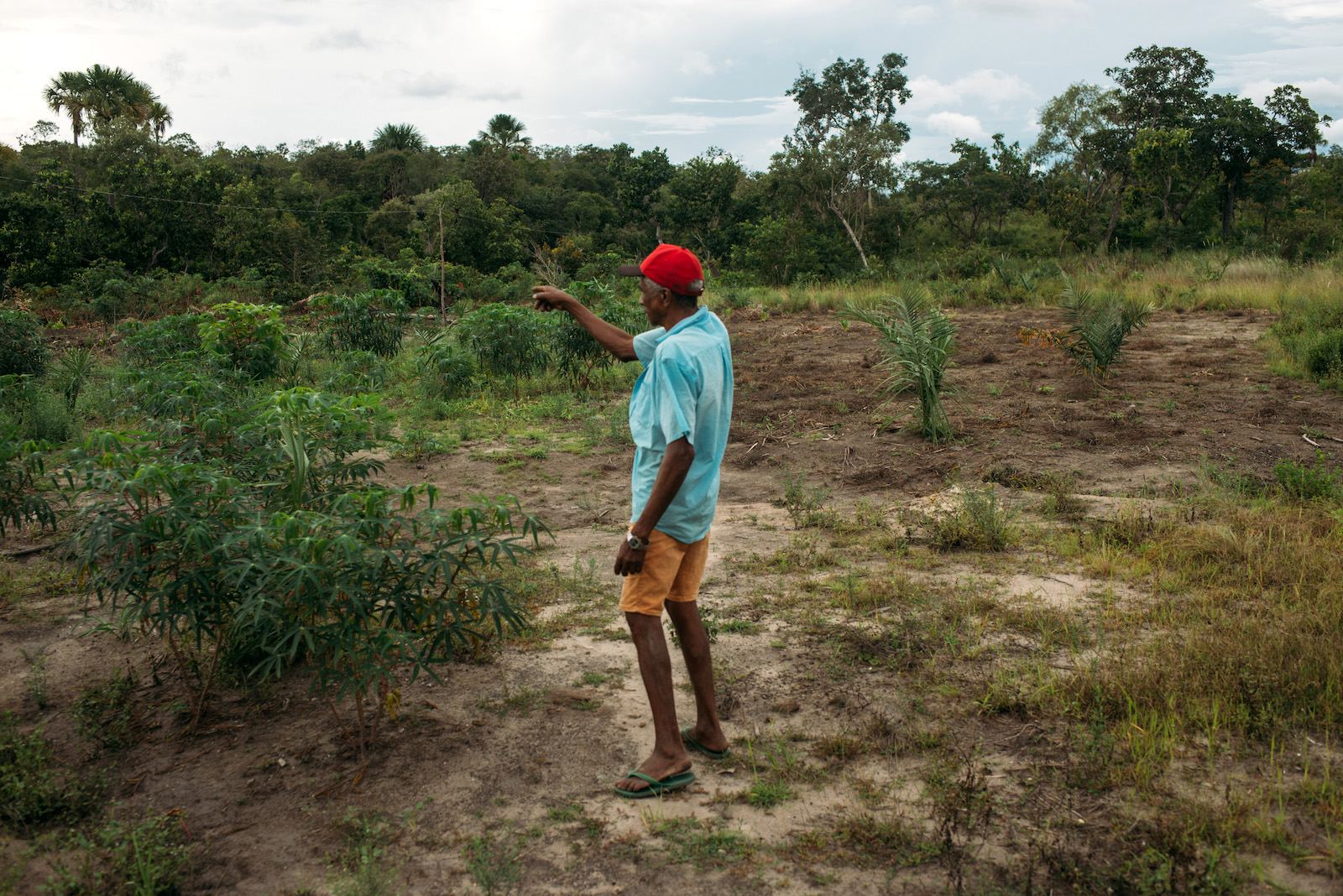This story was developed with the support of Journalismfund Europe.
In August 2020, Maria do Espirito Santo was returning from her family’s field in the savanna of northeast Brazil when she saw smoke billowing from her thatched hut.
Do Espirito Santo raced back to find that her home and those of her neighbors had been burnt to the ground by a group of armed men, some of them local police. They felled fruit trees, ripped up crops with tractors, and forced the small community of Bom Acerto from the lands where they had grown cassava, corn, and beans for generations. Afterward the families found out a businessman in Maranhao, the state she lives in, had laid claim to 10,872 acres of public land abutting 9,884 acres of land he had purchased, which includes the land that her family has been living on for generations. They suspect that he hired the men and bribed the police to come and terrorize the families so that they would leave.
“When we arrived, we found several dozen people, mainly women and children, huddling under the one remaining structure that cast any shade,” said Maciana Veira, president of the Sindicato dos Produtores Rurais de Balsas, the local rural workers association. Veira, in her decades of work for the association, has more accounts of land being stolen from rural communities than she can count.

Brazil possesses vast tracts of lands which exist in the public domain. Traditional peoples, small-scale farmers, quilombolas, and other homesteaders have the legal right to lay claim to these lands, but in rural Brazil, many communities like Bom Acerto still lack formal deeds. Those seeking to claim that land — often business owners or corporations — reportedly hire armed men to intimidate and run off residents. They then clear the land of trees or native vegetation, either seeding pasture for cows or preparing it to grow crops like soy, cotton, or corn. Eventually, they gain formal ownership through legal maneuvers or by forging land titles, sometimes by leaving falsified titles in a box with crickets, whose excreta makes the papers seem older than they are. It’s such a common practice that it’s picked up its own noun: grilagem, derived from the Portuguese for cricket, grilo.
Land grabbing is not a new phenomenon in Brazil, but it’s especially rampant in the 337 municipalities in the northern Cerrado that make up an area known as Matopiba (a portmanteau of the states Maranhao, Tocantins, Piaui, and Bahia.) The Cerrado, the world’s most biodiverse savanna, stretches 1.2 million square miles up the spine of Brazil, covering a fifth of the country. Squished between the Amazon rainforest on one side and the Atlantic rainforest on the other, it has been dubbed “the underground forest” because so much of its biomass is found in the long, thick roots that funnel water down into aquifers and store impressive amounts of carbon. Deforestation and land use change is Brazil’s single largest source of greenhouse gas emissions, so conserving the Cerrado, and its role as a carbon sink, is crucial for Brazil to meet its Paris Agreement goals. Much of the biome’s last remaining tracks of native Cerrado vegetation are in Matopiba, the country’s last agricultural frontier.
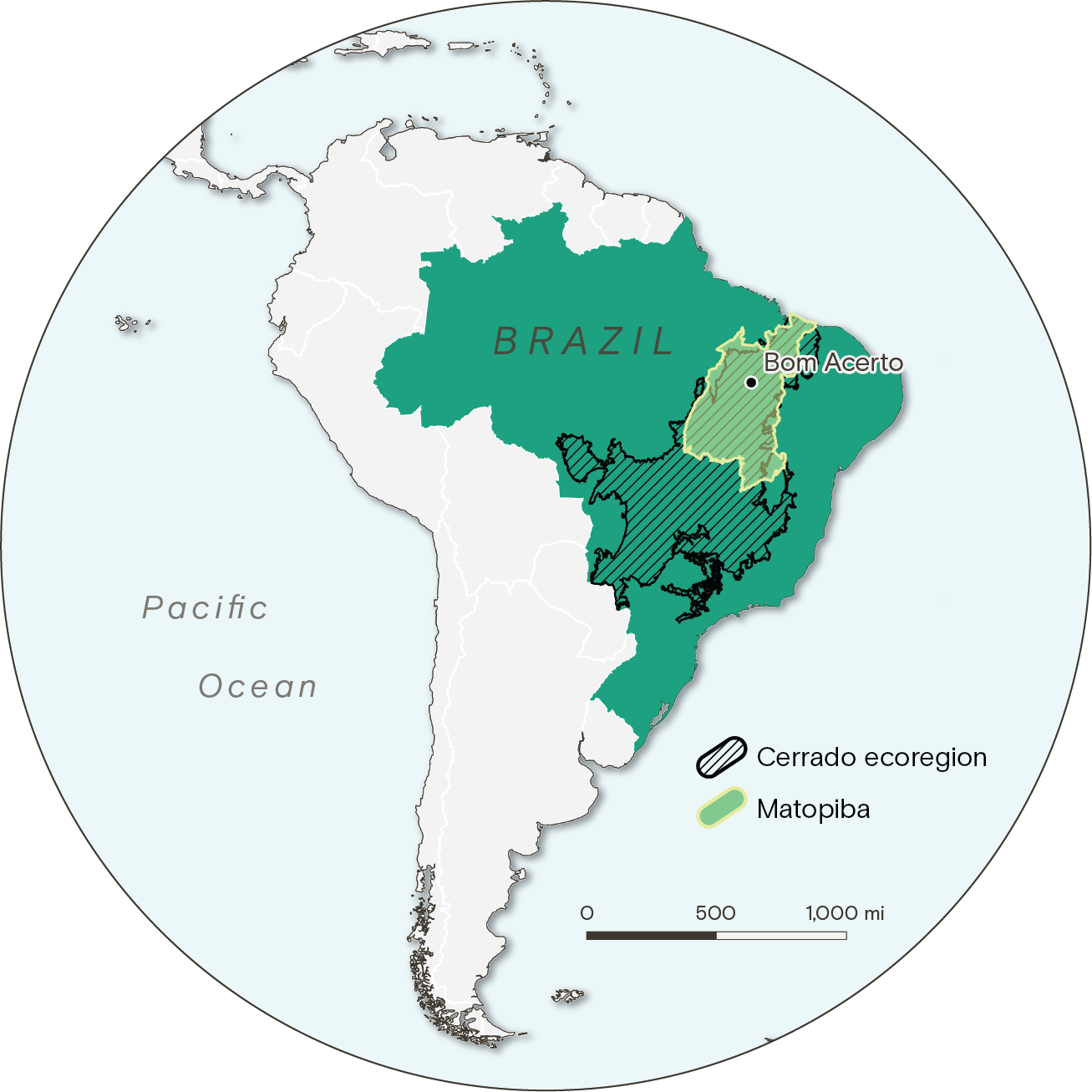
In Matopiba, some 1.7 million acres of native vegetation were ripped up and turned into soy plantations between 2013 and 2021, helping to turn Brazil into the world’s largest producer and exporter of soybeans. Most of the beans are used to fatten livestock in Europe and China, the two biggest buyers of Brazil’s crop. The usual narrative is that the destruction of the Cerrado is closely linked to the growing demand for meat and dairy. The full story, however, is more tangled and wider in scope: Behind this rapid and widespread transformation are some of the world’s largest investment funds that have put billions into buying farmland in the Cerrado, including pension funds in Sweden and Germany, Harvard University’s endowment, and the Teachers Insurance and Annuity Association, better known as TIAA, the $1.2 trillion pension fund for 5 million people across the United States.
Thanks in part to its investments in Brazilian farmland, TIAA has become one of the largest farmland investors in the world. Through its wholly owned subsidiary, Nuveen Natural Capital, the fund has accumulated some 3 million acres across 10 countries. It owns stakes in water-hungry almond and pistachio orchards in drought-stricken California, Macadamia nut farms and row crops in Australia, and vast swaths around the Mississippi Delta. But its investments in Brazil, where it manages 1 million acres, are some of its most controversial holdings.
Around the time of the financial crisis in 2008, TIAA and other investment funds started buying up farmland in Brazil, eventually honing in on the northern Cerrado, specifically Matopiba, where environmental protections are thin and land ownership is often in disputed. According to environmental organizations, academic researchers, satellite images, and media reports, many of the farms TIAA acquired are connected to land grabbing and deforestation. TIAA has regularly denied any knowledge of these practices, but emails and other leaked documents obtained from a data breach last year reportedly showed that as far back as 2010, TIAA was aware that some of the land it purchased was bought from people publicly accused of stealing it — groups like those that destroyed do Espirito Santo’s village of Bom Acerto. Despite an almost decades-long campaign by the Brazilian nonprofit The Network for Social Justice and Human Rights, along with environmental advocacy groups like ActionAid and Friends of the Earth, to get TIAA and other foreign funds to divest from their Brazilian landholdings, TIAA continues to raise money to invest in the region.
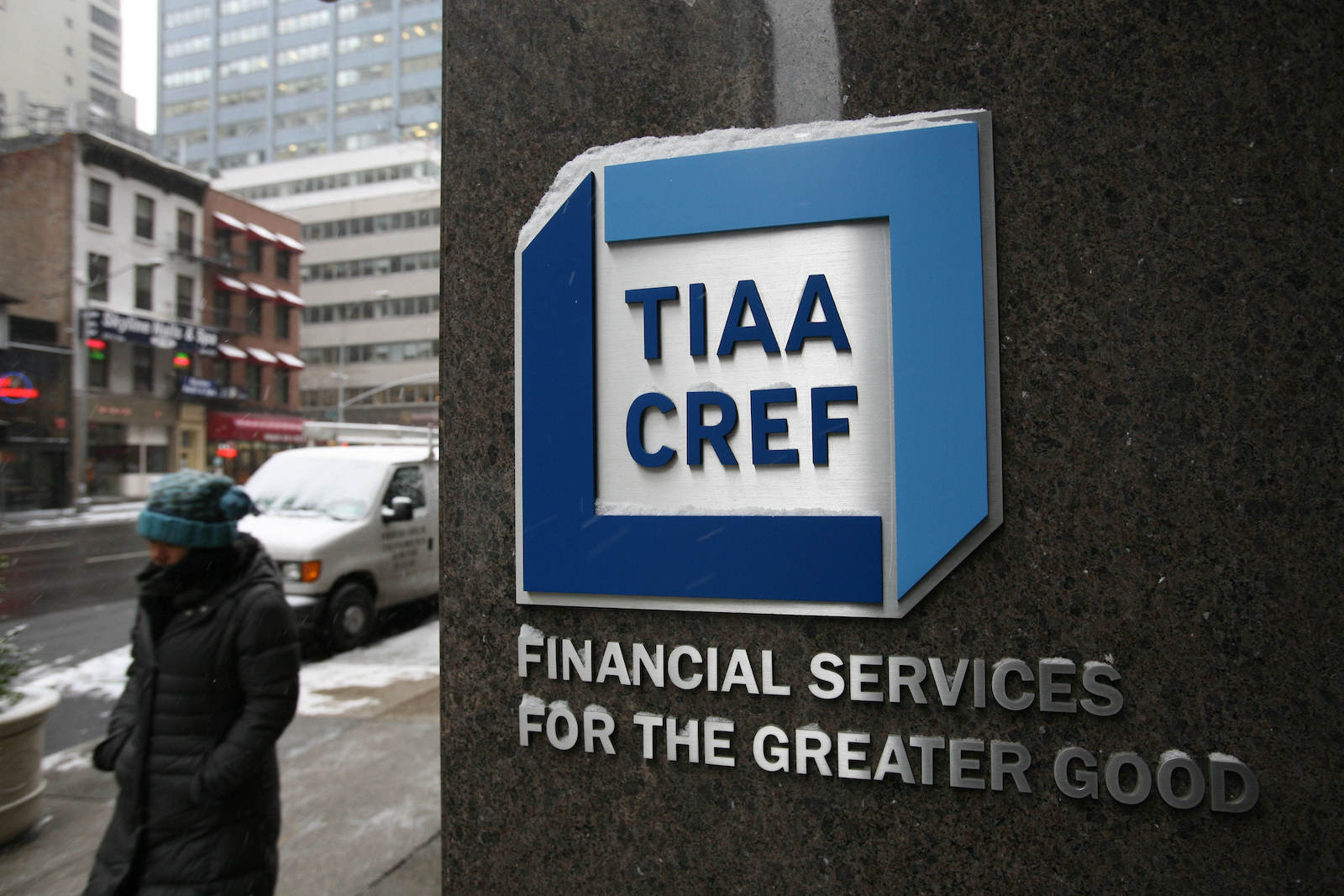
Connecting specific farms to specific investment funds is a complicated task, said Lucas Seghezzo, a professor of environmental sociology at the National University of Salta, Argentina, who studies large-scale land acquisitions. Investment funds often keep their assets private when they aren’t stocks and bonds, and following the money can lead to a maze of shell companies and chains of subsidiaries. Researchers wind up stuck in dead ends. Deforestation and land clearing is a complex process, and not every instance is directly connected to pension funds or investors. But experts have traced the massive influx of foreign capital in Matopiba to skyrocketing land prices in the region, which, in turn, has fueled land grabbing, deforestation, and violent conflicts, all with devastating consequences for local communities and the land itself.
“There’s a lot of evidence that investors who buy land in Latin America, for instance, but also in Southeast Asia, are responsible for deforestation — directly or indirectly,” said Seghezzo, who is also a scientific advisor to the Land Matrix Initiative, an independent monitoring initiative. “There is a clear correlation between land acquisitions and deforestation, especially those for agriculture.”
Bom Acerto is a two-hour drive from Balsas, an agricultural town in the heart of Matopiba. The route there is largely unpaved, passing over hills and through miles of scraggly shrubs and waving golden grass. The road dips occasionally from flat stretches of savanna into lush forests wedged into tiny riverine valleys. Far less known than the Amazon rainforest that borders the savanna to the north and west, the Cerrado is Brazil’s second-largest biome, covering an area larger than Germany, France, England, Italy, and Spain combined. It’s one of the oldest and richest ecosystems on Earth, with 5 percent of the planet’s biodiversity.

Much of the Cerrado has been plowed under for agriculture, especially in the southern and central parts of the savanna, which are closer to large urban centers like Sao Paulo and Brasilia, the country’s capital. Some of the last remaining swaths of intact Cerrado vegetation remain in the north, around places like Bom Acerto, which until the beginning of the 20th century had been largely occupied by peasant, Afro-Brazilian, and Indigenous communities.
Fabio Pitta has been studying the expansion of agriculture in the Cerrado since he was a university student researching sugarcane companies in the mid-2000s. Rising oil and gas prices and fossil fuel companies’ desire to appear “green” had stoked investments in sugarcane, which could be turned into ethanol when gas prices were high and used as sugar when they were low. The size of farms in the region was steadily growing, as were the number of laborers literally working themselves to death. Pitta set out to study this dynamic, focusing on Cosan, Brazil’s largest producer of sugarcane. He was puzzled to find that the company had started buying up large tracts of land in the Cerrado around 2008, thousands of miles from its home base near Sao Paulo in the southern Cerrado, through an investment arm it created called Radar Propriedades Agrícolas, or simply Radar.
More puzzling still was the identity of Radar’s second-largest shareholder, an investment fund run by what was then known as TIAA-CREF, the pension giant in New York City that manages retirement funds for millions of American teachers and professors.
Pitta was witnessing the convergence of two global crises. The U.S. financial crisis that started in 2007 sent big investors scrambling to find assets that weren’t tied to American real estate. Farmland, once considered a backwater and risky investment, gained overnight appeal. The surge in prices of basic staples that had started in 2005 had, by 2008, led to a fully fledged global food crisis. The commodities that could be grown on farmland suddenly became much more valuable, too. “Buying farmland was like buying gold with yield,” said Roman Herre, an agricultural expert at FIAN Germany, a human rights organization that advocates for the right to food. And global investors, Herre said, rushed to buy up whatever farmland they could.

More than 100 new investment funds specializing in food and agriculture were created between 2005 and 2008, and agricultural investment magazines and conferences ballooned. Famous investors like George Soros wanted in. Whereas in 2008, the annual expansion of farmland hovered around 9.9 million acres a year, by the middle of 2009, around 138 million acres worth of large-scale farmland deals had been announced, many of them larger than 500,000 acres, or two and a half times the size of New York City. It was dubbed “a new global land rush.”
“In the beginning, it was really more like a Wild West story,” Herre said. And one of the biggest players was TIAA, which went from having virtually no farmland in 2007 to holding just shy of 2 million acres worldwide within a decade.
But it wasn’t just teachers in the United States whose savings were providing the capital for the land rush. Dutch, Canadian, and Swedish public employees, along with German physicians, were also funding it. In 2012, TIAA launched its first international farmland fund called TIAA-CREF Global Agriculture LLC with $2 billion primarily from pension funds to invest in farmland, primarily in Brazil, Australia, and the U.S. The roster included Swedish AP2, then one of the largest pension funds in northern Europe, Germany’s Ärzteversorgung Westfalen-Lippe, a pension fund for physicians, and the Caisse de dépôt et placement du Québec, a public and private pension fund manager with around $176 billion in assets at the time. TIAA launched a second fund in 2015, the $3 billion TIAA-CREF Global Agriculture II LLC.
Figuring out exactly where these investments were located was difficult. Pension funds and other private investors don’t have to disclose precisely where their farmland holdings are, and investors often use complex business structures to buy farmland — particularly in places like Brazil, where foreign land ownership is legally restricted. Much of the data on TIAA’s investments comes from organizations like The Network for Social Justice and Human Rights, which Pitta now works for, that have traced the money through a messy web of subsidiaries and land acquisition companies, of which TIAA owns more than seven in Brazil, according to TIAA’s 2021 statements.
In 2016, the investment data company Preqin estimated that since 2006, more than 100 unlisted funds had raised approximately $22 billion in capital globally to invest in agriculture and farmland. TIAA’s investments, by far the biggest of any investor, made up almost a quarter of those.
“TIAA is really the vanguard of pension funds making this type of investment,” said Gustavo Oliveira, an assistant professor of geography at Clark University in Worcester, Massachusetts, who has been studying foreign investments in Brazil. “The important role that TIAA plays is not just on its own, because it’s got deep pockets and it invests in a lot of land. It is that once TIAA has ventured deep, it then becomes possible for smaller pension funds and other investors to follow in its wake.”
The northern Cerrado is crisscrossed by a handful of paved highways, lined on all sides by soybeans, that connect large agricultural hubs in Matopiba. In the rainy season, it’s a sea of bright green as far as the eye can see. Trucks thunder down the highways to and from large grain silos, many of them owned by international agricultural giants such as Bunge and Cargill which, alongside a few other companies, control more than half of the soy trade in Brazil. In the dry season, the soil lies bare and dusty, large piles of stark white lime piled up to one side, applied liberally to coax the otherwise nutrient-poor, acidic soil into producing what is now one of Brazil’s most lucrative exports. Over the last two decades, soybean production in Brazil has more than quadrupled.
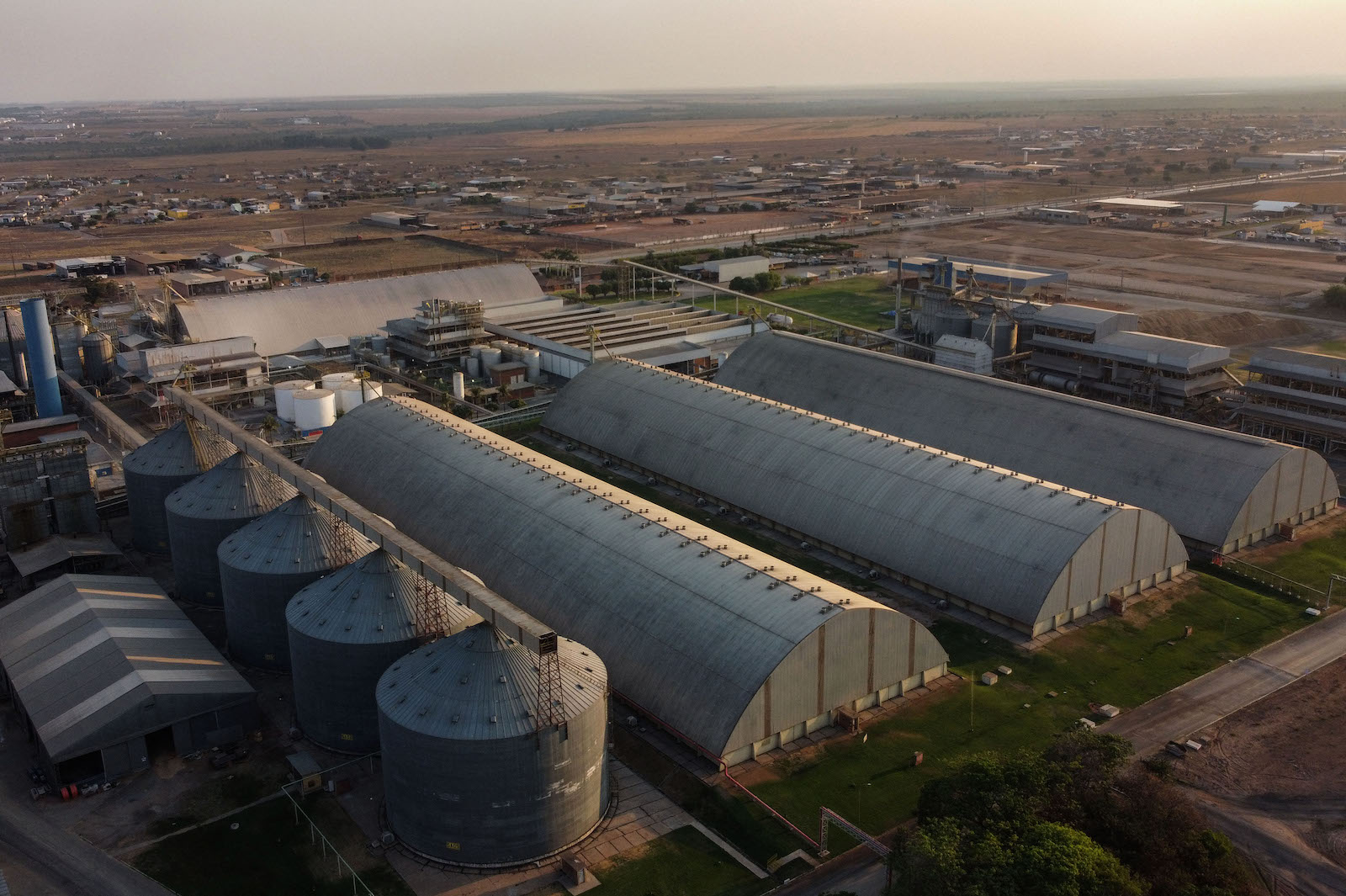
The farms are so large that their office complexes lie miles away from the highway, often on the iconic flat-top mountains called chapadas, ancient sandstone and quartzite formations formed tens of millions of years ago. While the rusty signs on the farms are largely in Portuguese, some of the owners are global. Between 2008 and 2020, Harvard Management Company, which manages Harvard University’s endowment fund, amassed more than 40 rural properties covering approximately 1 million acres, an area twice the size of all the farmland in the school’s home state of Massachusetts. BrasilAgro, whose shareholders include the Utah Retirement Systems, the Los Angeles City Employees Retirement System, and the Public School and Education Employee Retirement Systems of Missouri, owns a total of 741,000 acres in Matopiba. SLC Agrícola, one of the country’s largest soy producers and TIAA’s largest farm operator, and its sister organization SLC Landco, a joint venture with the British private equity fund Valiance, collectively bought up more than 450,000 acres of farms in Matopiba between 2011 and 2017.
While soybean farming has been expanding in the Cerrado for several decades, the relatively recent spread of soy into Matopiba, which has attracted the bulk of foreign farmland investment, stands out. “Matopiba is a relatively small portion of the Cerrado overall, but it is without a doubt the main expansion frontier for soy in the region,” said Lisa Rausch, a scientist at the University of Wisconsin-Madison who for the last two decades has studied how agricultural production leads to forest loss in Brazil.
Elsewhere in the Cerrado, soybeans tend to be grown on already converted land, often pasture. But in Matopiba, the vast majority of new farmland created since the turn of the century has been from previously intact Cerrado vegetation. According to Trase, a group that tracks global supply chains, three-quarters of all the deforestation from soybean production in the entire Cerrado from 2005 to 2016 happened in Matopiba alone. “One of the main features of soybean expansion in Matopiba has been its association with the clearing of native vegetation,” Rausch said.
Based on data obtained from the Network for Social Justice and Human Rights and Trase, Grist mapped the municipalities of farms that had significant investments from foreign pensions funds with information on which municipalities had the highest deforestation risk from soy farming. The results revealed that farms with significant foreign investment owned thousands to tens of thousands of acres in nine of the 10 municipalities that have experienced the most deforestation from soy from 2008 to 2020.
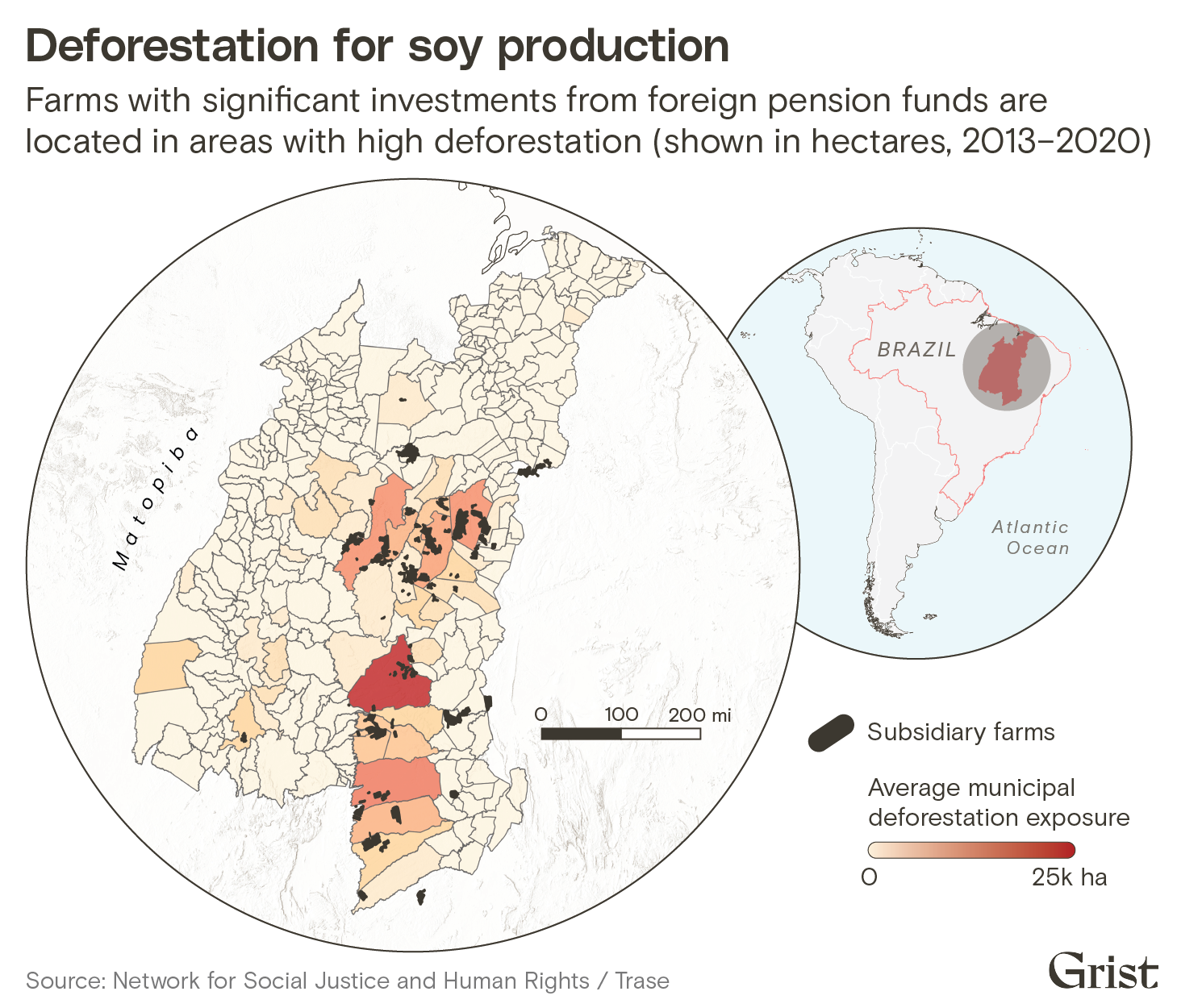
The loss of habitat threatens the region’s biodiversity, and consequently, the livelihoods of locals, many of whom depend on the forests and shrublands of the Cerrado for food and medicine. Alongside deforestation and foreign farmland investment, violent land conflicts in the region have also ballooned. Matopiba saw an overall 56 percent increase in reported land conflicts between 2012 and 2016, in contrast to a national increase of 21 percent. According to the Pastoral Land Commission, an organization affiliated with the Catholic Church that tracks conflicts in Brazil’s countryside, Bahia and Maranhao — both in Matopiba — ranked first and second among the states with the highest number of conflicts in 2022.
To be sure, some funds have dropped their investments in companies that deal in soy in the Brazilian Cerrado, some citing deforestation risk, others based on what they claim are financial reasons. The Norwegian Government Pension Fund and the Danish insurer Danica Pension divested their shares from SLC Agricola in 2017 and 2021, respectively. And last year, Germany’s pension fund for physicians in Westphalia-Lippe divested its shares from TIAA’s Global Agriculture Funds. But others have jumped in: In 2022, the Board of the Los Angeles County Employees Retirement Association committed around $500 million to TIAA-CREF Global Agriculture Funds, which encompasses its Brazilian farms.
The rapid expansion of large farms, funded by an influx of foreign capital, has reshaped the Cerrado’s landscape. The long, thick roots of vegetation store billions of metric tons of carbon, and have long funneled the region’s rainwater into aquifers. Two-thirds of Brazil’s rivers originate here, and nine out of 10 Brazilians use electricity generated by water originating in the Cerrado, according to the World Wildlife Fund. Now, so many trees and shrubs have been ripped out for soy fields, cattle, and sugarcane plantations that nearly half of the biome is cropland or pasture. Scientists predict that if agricultural expansion continues unabated, the biome could collapse by 2030, threatening the region’s drinking water as well as the thousands of unique species native to the world’s most biodiverse tropical savanna.
The soya boom is far from over. Brazil is expected to plant roughly 30 million more acres of soy between 2021 and 2050, according to one study. Of that, 27 million acres are destined for the Cerrado, and 86 percent of that is projected to be planted in Matopiba. But this is already coming at a cost. “The loss of native vegetation in the Cerrado has very serious consequences environmentally,” Rausch said. That loss has disrupted the region’s water cycle and has increased the frequency of extremely hot days in places like Matopiba, leading to more severe droughts. Climate change is likely to make all these problems worse.
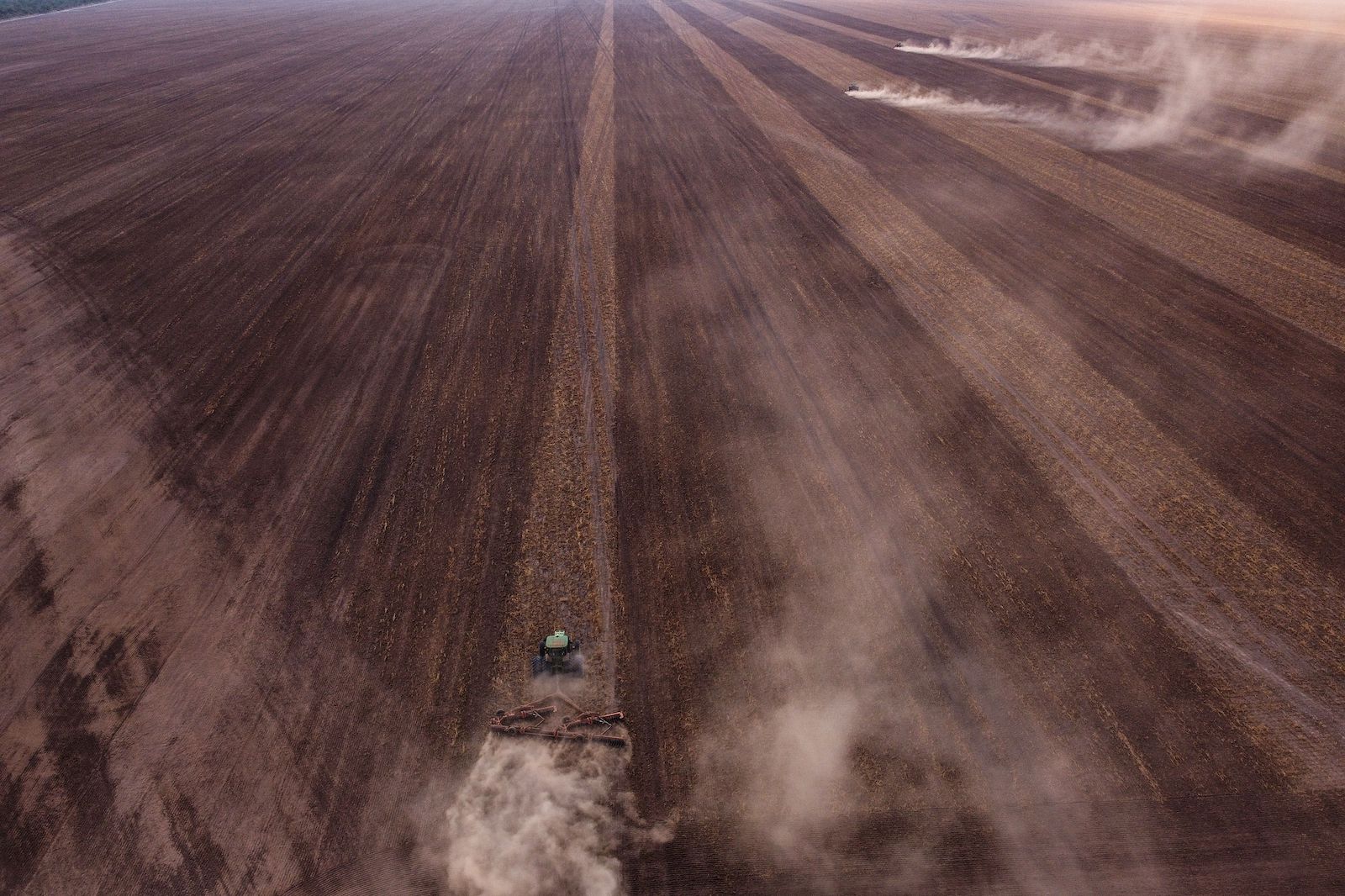
TIAA has previously said it invests responsibly and always carries out thorough due diligence on land purchases. But last year, a hacker group obtained 100 gigabytes of files from Cosan, Brazil’s sugarcane giant, through a ransomware attack, a trove that included sales documents, land holding records, legal papers, and emails, which were then handed over to Distributed Denial of Secrets, an activist group. They reportedly revealed that both Cosan and TIAA ignored red flags when buying Brazilian farms — even purchasing land from people who had already been publicly accused of stealing it.
Grist reached out to TIAA and its subsidiary Nuveen to respond to the information uncovered in the data breach and asked how the pension fund incorporates sustainability into its investment decisions. A spokesperson replied that TIAA and Nuveen evaluate the impact of their investments on local communities, make sure that the land they acquire and hold meets all government requirements for forest and natural habitat protection, and also ensure that their investments comply with local rules and regulations.
“Any suggestion that TIAA has engaged in improper business practices is without merit,” the spokesperson wrote. “In every country in which we operate, including Brazil, we follow the requirements of all laws and adhere to strong ethical guidelines in our investments. And we expect the government to investigate and prosecute instances of land-grabbing wherever it occurs.”
News of TIAA’s farmland holdings in Brazil first gained widespread attention in 2015 when a smattering of media reports began to lay out the extent of TIAA’s investments in the Cerrado. But it was a report in 2018 that detailed the scope and scale of Harvard endowment’s extensive landholdings in Brazil, written by the Network for Human Rights and Social Justice and the international nonprofit GRAIN, that gave the issue traction in the United States. The news spurred the growing fossil fuel divestment movement at Harvard to include land grabbing in its platform, forming the “Stop Harvard Land Grabs” campaign. Brazilian authorities were also starting to take notice, scrutinizing companies backed by Harvard’s endowment and TIAA.
In 2020, a small activist group called TIAA Divest tapped Caroline Levine, an English professor at Cornell University, to help lead a campaign to urge TIAA to get rid of its investments in fossil fuels and other environmentally destructive industries. Earlier that year, Levine had successfully helped win the campaign to get Cornell to divest its own endowment from fossil fuels, and she was riled up by what she saw as the blatant disregard for the environment and human rights that accompanied many of the investment decisions universities were making.
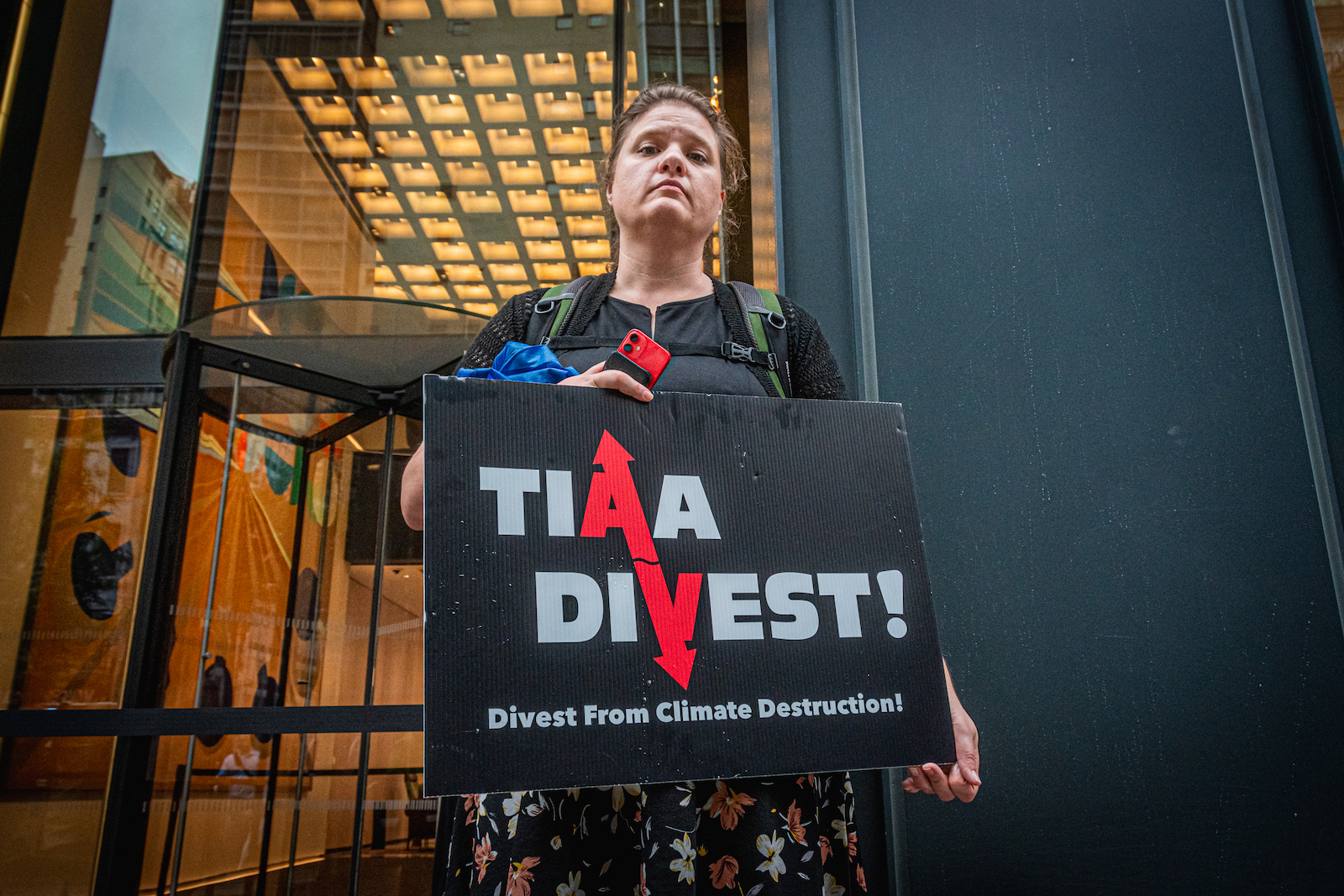
“I had this idea that financiers were sort of unaware of what was happening, that there’s a kind of distance between the investment and what’s going on on the ground,” Levine said. “But the more I looked at it, the more it seemed like, ‘No, there’s a lot of conscious bad action happening.’”
Levine and a dozen other professors started researching TIAA’s investments, but were taken aback by the sheer number of shell companies and the opaque web of financial flows. “I’m a researcher, but this really wasn’t my ballpark,” she said. They brought on Tom Sanzillo, a former New York state comptroller then working with the Institute for Energy Economics and Financial Analysis, who talked them through the financial hurdles. After two years of gathering evidence, they filed an 87-page complaint in October 2022 to the United Nations-sponsored Principles for Responsible Investment against TIAA and its subsidiary, Nuveen. Nearly 300 academics, researchers, and TIAA account holders signed on, including the climate scientist Michael Mann, the American academic Judith Butler, and the writer and activist Bill McKibben.
“TIAA/Nuveen’s climate commitments are contradicted by its substantial investments in fossil fuels and commodities linked to deforestation, which undermine the climate objectives established in the Paris Agreement,” the complaint states. “TIAA/Nuveen’s ongoing investments in coal, oil, and gas, as well as land-based investments linked to deforestation and illegality, are financially, morally, and socially irresponsible.”
TIAA was one of the founding signatories of Principles for Responsible Investment, or PRI, in 2006, which aimed to help investors make their funds more sustainable. The complaint argued that the $78 billion worth of investments in fossil fuels, as well as various environmental and human rights abuses connected to their large farm holdings in the Brazilian Cerrado, violated PRI’s principles, as well as TIAA’s own climate pledges. It charged that TIAA was misleading investors by advertising its funds as climate-friendly, making the case that many of its products marketed as being aligned with ESG principles — shorthand for environmentally and socially responsible — allegedly had higher exposure than non-ESG funds to fossil fuels and deforestation, the top two sources of greenhouse gas emissions in the world.
PRI signatories commit to six principles, including incorporating ESG matters into decision-making. While PRI has a serious violations policy, it is only sparingly applied, Levine said. In 2021, the Save the Dawson project in Australia filed a complaint to PRI about Liberty Mutual’s financing of a coal mine, which resulted in the global insurer canceling their financing. In October 2022, PRI said that it had reviewed Nuveen’s response to the allegations and “decided that the allegations do not constitute a breach of the policy. As such, there is no reason to change Nuveen’s status as a PRI signatory,” they wrote in an email response to Levine.
“We knew it was a long shot,” Levine said. Still, she considered the result disappointing.
University students, professors, and pension holders aren’t the only ones attempting to highlight the connection between foreign investment funds, deforestation, and land grabbing. Traditional communities and peasant farmers in Matopiba have protested in front of government agencies and blocked roads to bring attention to the problem. Last June, a delegation of leaders from several rural communities in Piaui handed a letter to government authorities asking for the state to protect them from ongoing violence and violations of their rights.
“Human rights violations in Piaui caused by land grabbing, deforestation, fumigation with toxic agrochemicals and other pollutants, as well as physical and psychological violence against rural communities, have been widely documented and brought to the attention of state and federal authorities,” the letter said. “The perpetrators of the violence are usually individuals linked to local land grabbers and/or agribusinesses, but research has shown that international investors play a key role in encouraging human rights violations and environmental crimes in the region.”
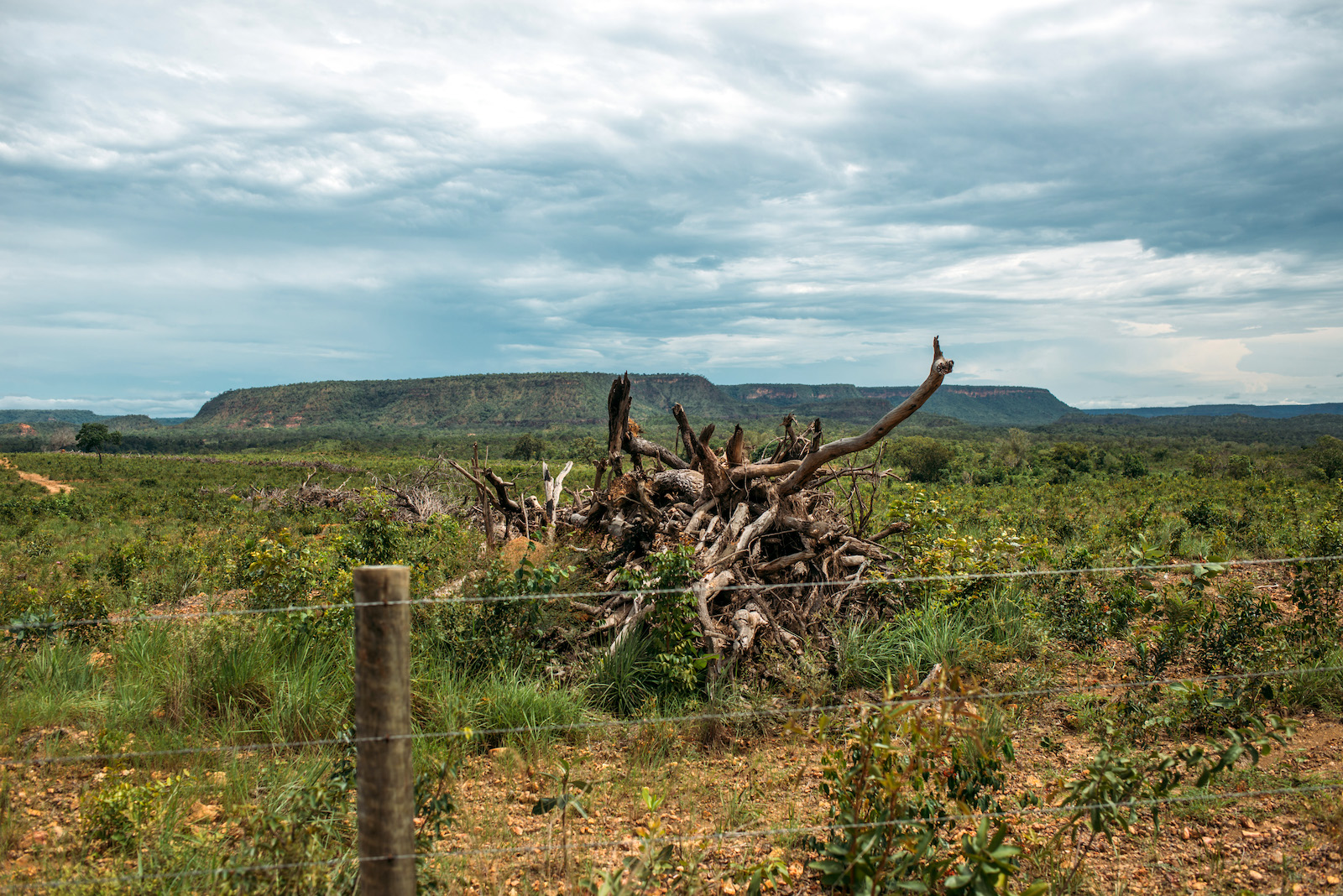
Around 10 miles from Bom Acerto, piles of native shrubs and vegetation cook in the punishing sun, their long, thick roots a contrast to the bright blue sky and the flat-topped mountains in the distance. For generations, the tops of these mountains were common areas used by peasants and Afro-descendent communities to forage for food, firewood, and medicines. People preferred to live in the more lush valleys, where crystalline rivers flowed. Nowadays, many of these rivers are polluted with agricultural runoff, and plantation owners keep ripping out more native vegetation. Just over the border from Bom Acerto, in Piaui, 5,000 acres of land was cleared in 2021 from a large farm, called Kajubar. In all likelihood, Pitta and other researchers predict, it will be sold to the highest bidder.
Though not all the deforestation in Matopiba can be directly linked to foreign investors, researchers agree that the scale and speed of destruction would not be possible without the massive influx of foreign capital. “Even if they sold all the enterprises, they profited from them a lot, and the impacts are still there,” Pitta said. Last year, the Stop Harvard Land Grabs campaign published a petition demanding that Harvard “stop investing in new farmland, return the lands already acquired to affected communities, and pay reparations for the undeniable harm of Harvard’s global land business.”
Meanwhile, forests continue to be torn down in the Cerrado at a fast clip. Between July 2022 and August 2023, deforestation in the region rose almost 17 percent, eating up more than 1.5 million acres of Cerrado vegetation, an area almost twice as large as Yosemite National Park. Around three-quarters of that was in Matopiba. According to the Pastoral Land Commission, more than 20,000 families in the four states were involved in conflicts over land in 2022, a record number.
In Bom Acerto, all that remains of the former settlement are piles of ashes and empty trails. The community has tried to take the businessman who is claiming he owns their land to court, but the case is stalled. Despite the uncertainty, the community has begun to rebuild some of the stalls for animals, and replant the fields with cassava, beans, and rice. Most of the trails end at the edge of the dry forest, where native Cerrado vegetation still extends for acres and acres into the horizon.

Last January, do Espírito Santo stood on the site of her old house and looked toward the village that she and her old neighbors are slowly piecing back together. “My dream is to stay here,” she said. “My dream is that we have the right to stay here, that we have the right to have our land and our home.”
At the end of August, four men in an unmarked pickup truck invaded Bom Acerto and set fire to a family’s house. Now, residents report that a drone constantly flies overhead. Most of the native Cerrado is still visible out beyond their fields, but for how long, do Espírito Santo doesn’t know.
